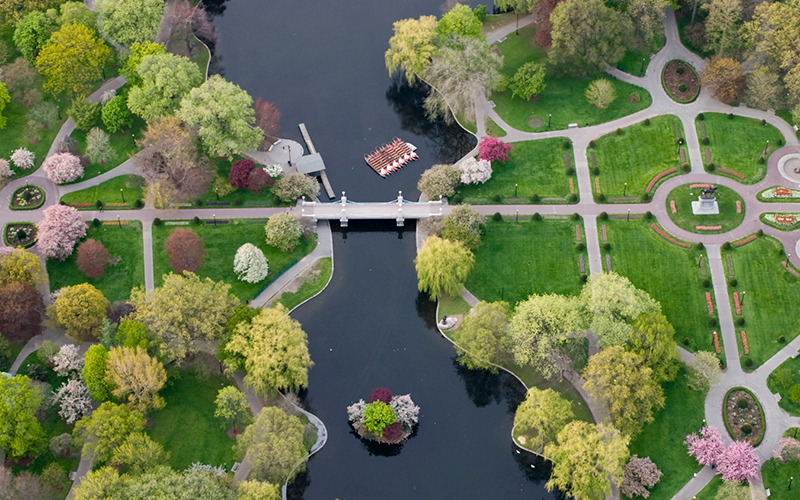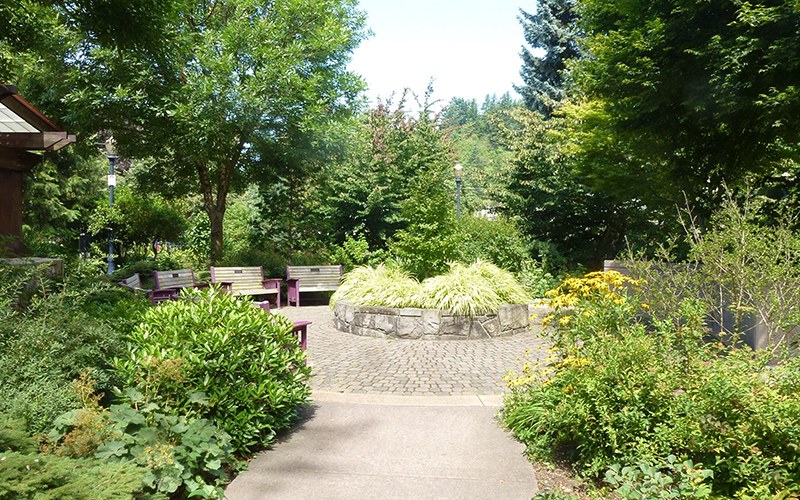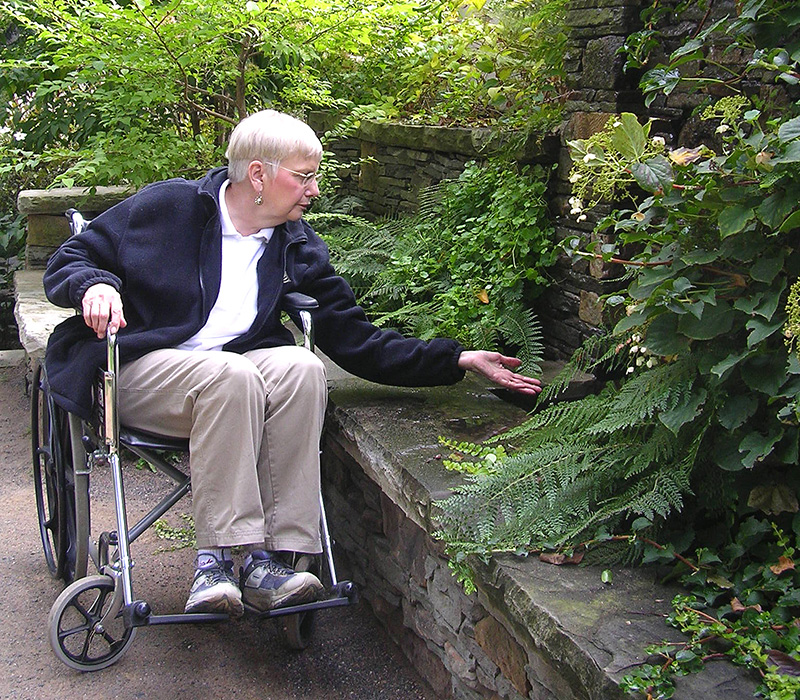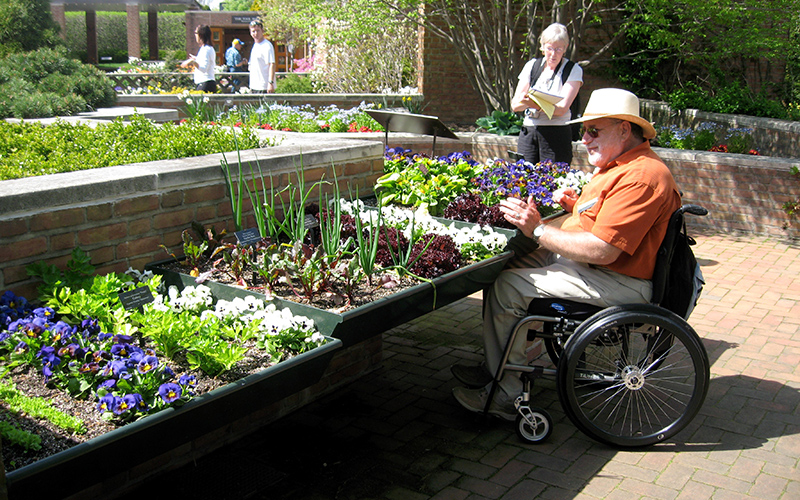Professional Practice
Universal Design: Gardens
 Boston Public Garden has wide flat pathways and seating located throughout extensive public gardens. Boston Public Garden, Boston, Massachusetts / Friends of the Public Garden
Boston Public Garden has wide flat pathways and seating located throughout extensive public gardens. Boston Public Garden, Boston, Massachusetts / Friends of the Public Garden Community and botanical gardens, which are sometimes found in parks, offer places of respite, opportunities to retreat and experience nature. There are many mental and physical health benefits to experiencing nature, but often gardens are designed in a way that limits access, decreasing the number of people who can enjoy them.
Sensory and therapeutic gardens can be beneficial to people with disabilities, who can enjoy the experiential array of visual, tactile, and olfactory sensory information. Spending time in these gardens, or engaging in the practice of gardening are types of horticultural therapy. Engagement with all the senses has been a traditional part of garden design, something lost in many modern gardens.
Gardens are a foundational form of landscape architecture. By applying universal design principles and including people with disabilities in the planning and design process, landscape architects can ensure gardens maintain their cultural importance into the future. Inclusive gardens include:
Seasonal planting: Choose a plant palette that highlights seasonal change through color, allowing those with neuro-cognitive disorders to track temporal changes. Plants that are non-toxic and non-thorny should be chosen so visitors can safely engage with the therapeutic benefits of nature. High contrast plantings help those with low vision to navigate spaces.
Circular or figure-eight paths: 6 out of 10 people with dementia wander. In gardens specifically designed for people with Alzheimer’s disease or other forms of dementia, circular, or figure-eight paths, with a single entrance, promotes walking as a directed activity, while limiting risk of wandering. In such spaces, a well-designed boundary to the garden disguised with planting is essential to prevent wandering and “elopement.”
The Portland Memory Garden, designed by Oregon ASLA as a pro-bono project led by Mark Epstein, Richard Zita, and Brian Bainnson, ASLA, is located within Ed Benedict Park in Portland, Oregon, and created for people with Alzheimer’s to exercise through safe walking. The circular walking path, with a single entry point, eliminates wayfinding concerns, focusing visitors on the act of walking. A fence encloses the garden, creating a single entry and exit point to reduce the risk of wandering. Benches along the path provide plenty of opportunities to rest, for both those with Alzheimer’s and their caretakers. Tree cover and lush planting make the garden a serene environment. Bathrooms are located with a clear line of vision so visitors can quickly reach them if the need arises.
 The Portland Memory Garden is designed for Alzheimer and dementia patients that are living with dedicated caretakers. The circular path, with a single entrance, encourages people to walk without the need for wayfinding. Seating around the edge of the walkway allows visitors to rest if they need to. Koch Landscape Architecture, Oregon ASLA Community Project led by Mark Epstien, Richard Zita, and Brian Bainnson, ASLA, Portland, Oregon / Brian Bainnson
The Portland Memory Garden is designed for Alzheimer and dementia patients that are living with dedicated caretakers. The circular path, with a single entrance, encourages people to walk without the need for wayfinding. Seating around the edge of the walkway allows visitors to rest if they need to. Koch Landscape Architecture, Oregon ASLA Community Project led by Mark Epstien, Richard Zita, and Brian Bainnson, ASLA, Portland, Oregon / Brian Bainnson Frequent, flexible seating: Seating with arm rests and backs should be scattered throughout the garden. Placing seating in shade helps to reduce sun exposure and increase time that can be spent outside. Flexible seating that is light enough to move encourages social engagement while in the garden.
Multi-sensory wayfinding: Specific smells or sounds should indicate transitions within a garden to increase the number of people who can navigate a garden independently. These markers can jog the memory of those with dementia and indicate potential hazards for people with low vision. Water is a good acoustic wayfinding method, but should be introduced safely.
The Elizabeth and Nona Restorative Garden in the Cleveland Botanical Garden, designed by Dirtworks, PC, uses multi-sensory navigation to help blind people or those with low vision, such as changes in humidity and temperature and the sound of water trickling down stones, near the water.
 The Elizabth and Nona Restorative Garden has low walls, that can be used as seating, but also allow wheelchair users to enage with the plantings and water features in the garden. ASLA 2006 Professional Honor Award. The Elizabeth and Nona Restorative Garden Cleveland Botanical Garden, Cleveland, Ohio. Dirtworks, PC / K. Duteil
The Elizabth and Nona Restorative Garden has low walls, that can be used as seating, but also allow wheelchair users to enage with the plantings and water features in the garden. ASLA 2006 Professional Honor Award. The Elizabeth and Nona Restorative Garden Cleveland Botanical Garden, Cleveland, Ohio. Dirtworks, PC / K. Duteil Limited level changes: Gardens that are flat are safer for those who are blind or have low vision, wheelchair users, or those with cognitive disabilities. Grade changes lacking visual or tactile cues can be trip hazards for deaf and hard of hearing people who rely on sign language and visual lines of sight. If level changes are necessary, use multi-sensory wayfinding, including tactile paving, methods to mark these locations.
Easily accessible bathrooms: Restrooms should be located within line of sight to ensure easy access to all visitors. Signage should be located throughout the garden to indicate the location of the nearest restroom to ensure quick access when the need arises.
Engagement: Direct engagement with growing plants fosters community and can combat loneliness and offer intergenerational connections, among other benefits. Raised beds provide easier access to the soil and can provide seating or wheelchair access throughout the garden. Gardening has also shown to be beneficial for people with mental illness, cognitive disabilities and autistic, or otherwise neurodivergent people.
 Pashek + MTR co-designed the Buehler Enabling Garden at the Chicago Botanical Garden with Gene Rothert, founding director of the enabling garden, who uses a wheelchair. Raised beds of varying heights provide access to horticultural therapy for users of different kinds of wheelchairs, blind or low vision people, those who use walkers or want to sit and garden. Raised beds lined with stone walls provide informal seating for all visitors along with benches. Buehler Enabling Garden at the Chicago Botanical Garden, Chicago, Illinois, Pashek + MTR / Clare Cooper Marcus
Pashek + MTR co-designed the Buehler Enabling Garden at the Chicago Botanical Garden with Gene Rothert, founding director of the enabling garden, who uses a wheelchair. Raised beds of varying heights provide access to horticultural therapy for users of different kinds of wheelchairs, blind or low vision people, those who use walkers or want to sit and garden. Raised beds lined with stone walls provide informal seating for all visitors along with benches. Buehler Enabling Garden at the Chicago Botanical Garden, Chicago, Illinois, Pashek + MTR / Clare Cooper MarcusSafe materials: Safe materials, suitable for gardens, are low-glare, not slippery when wet, flat, have high contrast between each other, and tactile. Textural contrast, of both hardscape and natural materials, provides greater clarity for people with low vision and allows for a sustained line of sight for deaf and hard of hearing visitors as they sign. Eliminating glare, both from ground materials and the sun, is also important for those who use sign language.
Secluded areas: Areas to engage in private contemplation or to isolate from sensory stress should be located throughout the garden. For autistic people, secluded areas help manage overstimulation. Muted colors in these areas can reduce chances of further overstimulation.
Organizations
American Horticultural Therapy Association
Alzheimer’s Association
Enabling Environments
Horticultural Therapy Institute
Therapeutic Landscapes Network
Resources
AARP HomeFit Guide, AARP
A Democratic Approach to Therapeutic Gardens, The Dirt, June 2014
Are Therapeutic Gardens Safe, The Dirt, March 2014
Benefits of Daily Outside Walk and Dementia Gardens for Persons with Dementia, National Council of Certified Dementia Practitioners, 2010
Benefits of Gardening, AARP, June 2017
Empathize and Then Design, The Dirt, March 2017
Interview with Clare Cooper Marcus on the Healing Power of Nature, The Dirt, November 2017
It’s Official – Spending Time Outside is Good for You, Science Daily, July 2018
Landscape Design for Dementia Care, Housing Learning and Improvement Network
Planning a Garden for Persons with Alzheimer’s, Very Well Health, October 2018
Sensory Gardens, The Field, October 2016
Walking Slows Progression of Alzheimer's Disease, MDedge, January 2011
Research
Aerobic Exercise Promotes Executive Functions and Impacts Functional Neural Activity Among Older Adults with Vascular Cognitive Impairment, Chun Liang Hsu, John R Best, Jennifer C Davis, Lindsay S Nagamatsu, Shirley Wang, Lara A Boyd, GY Robin Hsiung, Michelle W Voss,Janice Jennifer Eng, Teresa Liu-Ambrose, February 2018
Therapeutic Gardens for the Elderly, Mark B Detweiler, Taral Sharma, Jonna G. Detweiler, Pamela F. Murphy, Sandra Lane, Jack Carman, Amara S. Chudhary, Mary Halling, and Kye Y. Kim, MD, May 2012
Projects
Buehler Enabling Garden, Chicago Botanical Garden, Glencoe, IL, Pashek + MTR
Dom Podmurvice Community Garden, Reijeka, HR, University of Washington, Design Build Team, ASLA 2018 Student Honor Award, General Design
Elizabeth and Nona Restorative Garden Cleveland Botanical Garden, Cleveland, OH, Dirtworks, PC, ASLA 2006 Professional Honor Award, General Design
The Florence Fang Asian Community Garden, San Francisco, CA
Portland Memory Garden, Portland, OR, Quatrefoil Inc., 2001